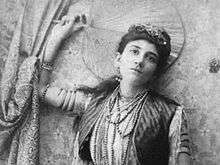Rachel Beer
| Rachel Beer | |
|---|---|
 | |
| Born |
Rachel Sassoon 7 April 1858 Bombay, India |
| Died |
29 April 1927 (aged 69) Royal Tunbridge Wells, England |
| Occupation | Editor |
| Religion | born Jewish; converted to Christianity |
| Spouse(s) | Frederick Arthur Beer (1887–1903) |
| Relatives | Siegfried Sassoon (nephew) |
Rachel Sassoon Beer (7 April 1858 – 29 April 1927) was an Indian-born British newspaper editor. She was editor-in-chief of The Observer and The Sunday Times.
Early life
Rachel Sassoon was born in Bombay to Sassoon David Sassoon, of the Iraqi Sassoon family, one of the wealthiest families of the 19th century; indeed, he was known as the "Rothschild of the East."[1] As a young woman, she volunteered as a nurse in a hospital.
In 1887, she married the wealthy financier Frederick Arthur Beer, son of Julius Beer (1836–1880), and converted to Christianity. Frederick, an Anglican Christian, was also from a family of converts. In the wake of her conversion, the family disowned her.[2]
The Beers had their roots as a banking family in the Frankfurt ghetto. In the UK they were financiers whose investments included ownership of newspapers.[3]
Journalism career
Soon after she married Frederick, she began contributing articles to The Observer, which the Beer family then owned. In 1891, she took over as editor, becoming the first female editor of a national newspaper in the process.[4] Two years later, she purchased the Sunday Times and became the editor of that newspaper as well. Though "not . . . a brilliant editor",[5] she was known for her "occasional flair and business-like decisions".[6]
It was during her time as editor that The Observer achieved one of its greatest exclusives: the admission in France by Count Esterhazy that he had forged, under instructions from his superiors, the letters that had falsely convicted the innocent Jewish officer Captain Dreyfus[7] leading to his incarceration on Devil's Island. The story provoked an international outcry and led to the release and pardon of Dreyfus and court martial of Esterhazy.
Last years
Frederick died of syphilis in 1903, having passed it on to his wife.[8] Her own behaviour grew increasingly erratic,culminating in a collapse. The following year she was committed and her trustees sold both newspapers. Although she subsequently recovered, Beer required nursing care for the remainder of her life, spending her final years at Chancellor House in Tunbridge Wells, where she died of the disease in 1927.
Though Beer's husband Frederick was buried in his father's enormous mausoleum in Highgate Cemetery in north London, Rachel's family intervened to prevent her burial in that bastion of Anglican religion. Instead she was interred in the Sassoon family mausoleum in Brighton, Sussex. Among her relatives was the poet Siegfried Sassoon, who was her nephew and to whom she left the bulk of her fortune.
Her brother, Alfred, had been cut off by his family for marrying outside the Jewish faith; though Rachel had also married a gentile, in her case the action was forgivable because of her sex. In her will she left a generous legacy to Siegfried, enabling him to purchase Heytesbury House in Wiltshire, where he spent the rest of his life. In honour of her bequest, Siegfried hung an oil portrait of his aunt above the fireplace.
References
- ↑ Hertog, Susan. "The First Lady of Fleet Street". Jewish Ideas Daily. Retrieved 21 May 2012.
- ↑ The life and death of Rachel Beer, a woman who broke with convention
- ↑ Financial Times, 7 & 8 May 2011, p.17.
- ↑ The Observer, 8 May 1983, p. 39
- ↑ http://lrb.veriovps.co.uk/v27/n02/coll01_.html
- ↑ Stanley Jackson, The Sassoons: Portrait of a dynasty, p. 95.
- ↑ Nina Macintyre "The First Lady of Fleet Street", Prospect (blog), 19 June 2013
- ↑ History of a foxhunting man The Guardian, 5 August 2003
Bibliography
- Jackson, Stanley (1989). The Sassoons: Portrait of a Dynasty. William Heinemann. ISBN 0-434-37056-8.
- Curney, Vanessa (2004). ""Beer [née Sassoon], Rachel". In Matthew, Colin; Brian Harrison. Oxford Dictionary of National Biography. 4. Oxford University Press. pp. 816–817.
- Negev, Eilat and Yehuda Koren (2011) The First Lady of Fleet Street: A Biography of Rachel Beer. (London: JR Books). ISBN 978-1-906779-19-1
| Media offices | ||
|---|---|---|
| Preceded by Henry Duff Traill |
Editor of The Observer 1891–1904 |
Succeeded by Austin Harrison |
| Preceded by Arthur William à Beckett |
Editor of The Sunday Times 1893–1901 |
Succeeded by Leonard Rees |